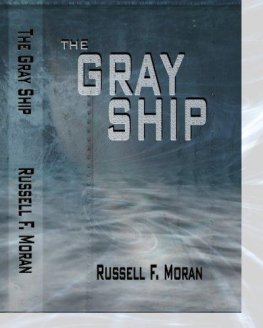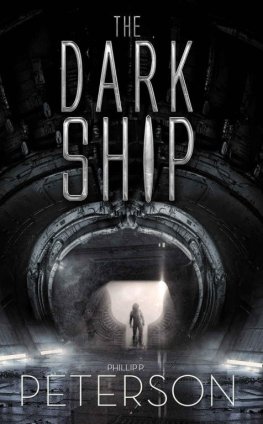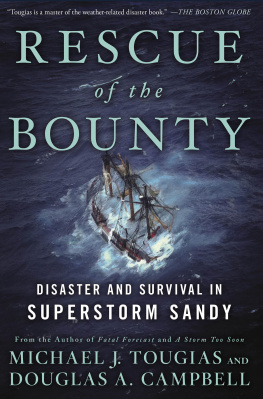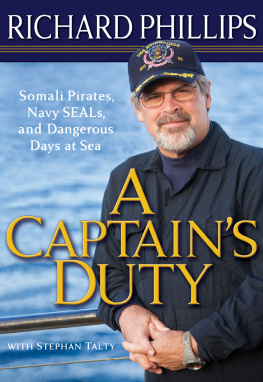Russell F. Moran
THE GRAY SHIP
A story begins with an idea, which then develops into a concept that eventually becomes the story. Like most of my work, this book began with conversations with my wife, Lynda. I have always been a Civil War buff, fascinated by its grandeur and its horror. The idea of a modern warship in the Civil War popped into my mind during one of those conversations. To pull that off, of course, I knew that the book would be based on the science fiction sub-genre of time travel. Thats the only way I could get a nuclear powered cruiser to 1861. I enjoyed The Final Countdown by Martin Caidan, the 1980 novel about the USS Nimitz getting caught in a time portal during a freak electric storm and time travelling to Pearl Harbor on the eve of the attack. Lynda and I talked for hours about the captain and his (or her) character. Ashley Patterson became part of the concept.
This is a work of fiction, and any similarity between a character and a living person is a coincidence. There are, however, historical figures in the book, including Abraham Lincoln, Jefferson Davis and President Barack Obama. Although these are real people, the scenes in which they appear came out of my head.
An author cant be his own editor. Youre too close to the subject. You skip over the grammar and punctuation because youre concentrating on The Story. No matter how many revisions you go through, you are bound to miss a lot of errors. An editor looks for grammatical and punctuation errors, but he also brings a fresh eye to the story itself and spots inconsistencies. I thank my friends Bill Holland from Olympia, Washington and Nick Wartella from Sayville, New York for their bi-coastal efforts. I also thank my wife Lynda for her countless hours of input into this novel.
I also thank my friend Lloyd (Hoss) Miller, Rear Admiral, Retired, United States Navy. Admiral Miller was the first commanding officer of the USS California, the ship that plays the pivotal role in the story. His technical input was invaluable, but I must emphasize something here. This is a work of fiction, and because its a novel, I changed some facts to serve the story. For one thing, I had to bring the California out of mothballs for The Gray Ship because the ship had been decommissioned in 1999. I also added Tomahawk cruise missiles to the ships arsenal, although the historic California didnt carry them.
Admiral Miller makes a cameo appearance in the book, but obviously the scene is fictional. I wont tell you why its obvious. Youll find out. In the scene, Admiral Miller is a strong leader, a gentleman, and a very likeable person. Thats not fiction. Thats the truth.
I hope you have as much fun reading this book as I had writing it.
Captain, we have a problem.
Captain Patterson hit the reply button on the intercom next to her bed.
What is it, Lieutenant?
It feels like were going aground, Maam.
Because the Captains sea cabin is only 10 feet away, shes on the bridge in seconds. She always wore fresh fatigues to bed so she can respond to an emergency in uniform, not a bathrobe. It is 0307 (3:07 A.M.).
The ship went through a strange turbulence, an underwater commotion the likes of which no one on the ship had ever experienced, a soft bumping sensation, not like waves, but more like the ship was riding over a herd of whales. In 30 seconds, the bumping stopped.
Whats our depth, Lieutenant?
Sonar shows 200 feet, Captain.
Any sign of marine life?
No, Maam. Sonar shows nothing between us and the bottom except water.
Damage control report?
Nothing so far Captain except for a few broken dishes in the mess hall.
What happened next was an event that would forever change the lives of the crew of the USS California. At 0309, the dark night changed to a bright noon. The sun was high in the sky, and the sweet smell of ozone, when the bright sun mingles with the ocean, was as pleasant as it was terrifying.
All departments reported to the bridge in order of protocol.
Captain, weve received reports from almost every department, said the Officer of the Deck. Engine room, AOK; reactor room, AOK; after-steering station, AOK
Lieutenant, please tell me whats wrong, not whats right.
Aye, Captain. Weve lost all GPS navigation, ship-to-shore communications, and ship-to-ship communications. We have no Internet connections, email, or cell phone service.
* * *
Petty Officer Third Class Andrea Dunne was exchanging text messages with her mother in Norfolk, Virginia. Her mother has liver cancer, and she is getting worse every day.
Mom, please tell me the truth. Dont try to make me feel better, I want you to feel better.
Well, honey, the doctor was just here and he said There was no more message. Dunne was frantic. Her mother was about to tell her something important and the message stopped. She tried to send email, but the send command didnt work. The message on her IPhone said that there was no cellular network available. She tried to phone, but got the same message: no cellular network available.
* * *
Lieutenant Kevin Fitzpatrick stood watch in the Combat Information Center doing a routine check of satellite positions. The software displayed a computer simulation of satellites in range of the California. Suddenly, all satellite images disappeared from his screen. He tried to ping the code for each satellite. Not one responded. He assumed it was a software malfunction. Dozens of satellites cant just disappear, Fitzpatrick thought.
* * *
At the Pentagon, Lieutenant Fran Talierco was on watch at the Office of Naval Operations, NavOps. Her job, as deputy watch officer, was to monitor the positions of all Navy ships in the Eastern Atlantic via Global Positioning System or GPS.
Oh my God, yelled Talierco, wheres the California?
Lt. Commander Frank Orzo, the Duty Officer, hurried to Taliercos station. What happened Fran?
The California just disappeared, said Talierco. Because every ship had multiple redundant GPS devices aboard, they both knew it was impossible for a ships position to disappear if one malfunctioned. That could only happen if a ship sank.
Call them by phone, said Orzo. Talierco called the satellite number for Captain Ashley Patterson, the CO of the California. A recorded message said, The number you are calling is not in service at this time. She tried the number of the Executive Officer of the California. Same message.
Ill try the Ticonderoga to see if they can get the California on radio, Talierco said. The USS Ticonderoga steamed twenty miles east of the Californias last position. Talierco spoke to the Officer of the Deck (OOD) on the Ticonderoga who immediately radioed the California.
I get no response, Lieutenant, said the OOD on the Ticonderoga.
Get Admiral Friese on the phone, Fran, Orzo said. Talierco hit the emergency line for the Deputy Chief of Naval Operations.
* * *
Lt. Commander Dominic Valente, the Californias Supply Officer, arose early so he could get some work done without interruption. He ordered supplies for the next two months using newly installed supply software. He went through the on-screen menu of items, which calculated the amount needed based on the size of the crew and the length of deployment. Valente loved that the software was cloud based, meaning that the data was on a distant server farm somewhere in the Midwest and could be updated instantly. His screen flashed the message that the network wasnt responding. This is crazy, thought Valente. We must have a dozen different Internet connections on this ship. But his workstation could not pick up one of the ships networks. Wow, thought Valente. Were totally off the Web. He called Lieutenant Jason Terhune, the ships IT officer.









